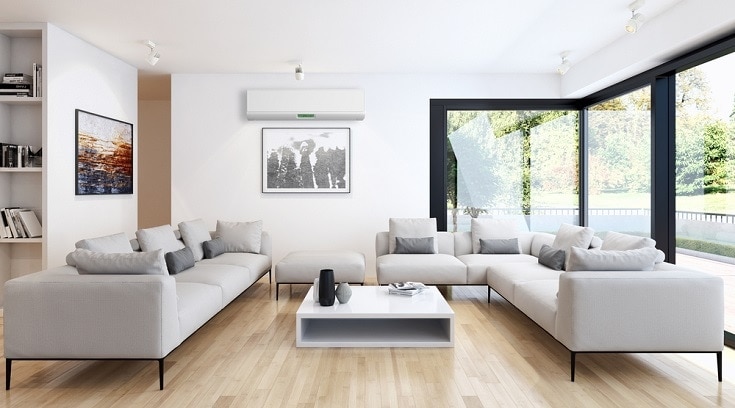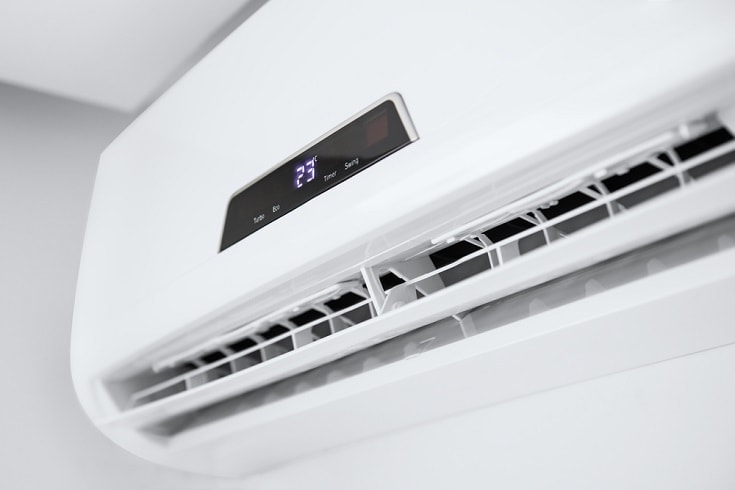What’s the Best AC Temperature for Saving Money? Facts & Tips
-
Brooke Bundy
- Last updated:

Whether you enjoy a freezing cold blast of AC during the summer or the smoldering hot breath of the heater during the winter, it is best to avoid extremes on both ends in order to save money. Keeping your thermostat set to around 68°F when you’re home in the winter and 72°-78°F in the summer should help you achieve an ideal balance of comfort and cost. We’ll dive into the recommended thermostat temperatures for each season, as well as ways you can make your house feel comfortable without raising your electric bill.
Normal Thermostat Temperature
Americans have vastly different opinions regarding comfortable indoor temperatures. According to a survey¹ of 2,000 people, Americans say 64°F is the perfect indoor temperature during the summer months. In general, males actually prefer cooler temperatures¹ than females, which is one reason why restaurants feel like an ice chest during July (in addition to the subtle fact that cooler temperatures make you hungrier¹) .
However, a frigid 64°F makes the outside world feel even hotter when you emerge from your icy cocoon, and burns through your electricity bill. Optimally, you should set your thermostat as close to the outside temperature as you comfortably can in all seasons.

Suggested AC Temperature in Summer
The U.S. Department of Energy¹ suggests that you try to keep your thermostat between 72°-78°F in the summer, at least while you’re in the house. It’ll help your energy bills if you raise the thermostat to 82°-85°F when you’re gone from home, or while you’re sleeping if you feel comfortable.
Suggested AC Temperature in Winter
Aim for 68°F during the colder months. It’s generally recommended to turn down the thermostat a few degrees cooler for at least eight hours. Some people prefer this brief colder period to take place during the workday when it’s warmer outside and they’re probably out of the house. Others claim to sleep better in the colder temperatures because there’s always the option of burrowing under covers.

Suggested AC Temperature in Spring & Fall
We suggest keeping your thermostat set at a moderate temperature during the in-between seasons. Since the extreme heat has faded away, or hasn’t yet arrived, you probably can get away with turning on the ceiling fan and skipping the AC altogether. If it’s still cool outside, try running a space heater or throwing on an extra blanket instead of cranking up the thermostat. Instead of alternating between cold and heat, try switching your thermostat to “fan-only” mode, which will circulate the air and moderate the temperature.
The 3 Ways to Maintain a Comfortable Temperature Without a Crazy High Electric Bill
Air conditioning has been around for fewer than one hundred years, so for the majority of human history, we’ve figured out alternate ways to keep cool. Here are a few ways to beat the heat without raising your bill.
1. Check the Seals on Your Doors and Windows
Cracks around exterior seals allow freshly cooled air to escape into the steamy outdoors. Making sure your house doesn’t have gaping holes around your exterior doors and windows helps you maintain the ideal temperature indoors and prevents your central unit from running continuously.
2. Turn on the Fan
Conversely, if your home is sealed tightly, air might not be circulating as well as it should, resulting in a stuffy house. Turning on the ceiling fan or portable fan will keep the air from becoming stale. Oftentimes, you just need moving air to feel cooler, not necessarily a cold blast of AC.

3. Draw the Shades
Closing the blinds and curtains in the heat of the day can prevent streaming sunlight from excessively heating up your home. Make sure the blinds and curtains are closed at night in the winter, too, to prevent drafts from coming into the room.
Central vs. Window Air Conditioning
If you really want to cut your electricity bill, consider installing window units instead of using a central unit. This is most efficient if you have a smaller house needing fewer than five window units. If you install more than five, then the window units will actually draw more electricity than a central unit, and your efforts will be futile.
Conclusion
No one wants to sweat beads while sitting in their home office, or shiver uncomfortably in the wee hours of the night. We consider central heat and air one of the finest human achievements of the last hundred years, and we’re not planning on abandoning our units anytime soon. However, there are ways to maintain a reasonable temperature in your home without excessive electricity bills and a continually running central unit. Keeping your thermostat set to around 68°F when you’re home in the winter and 72°-78°F in the summer should help you achieve an ideal balance of comfort and cost. Running the thermostat about ten degrees hotter in the summer and colder in the winter when you’re not home should also lower your costs.
- https://studyfinds.org/summer-air-conditioning/
- https://www.eatingwell.com/article/7959323/why-you-feel-hungrier-when-its-cold-out/
- https://www.discovermagazine.com/mind/room-temperatures-set-for-mens-comfort-may-disadvantage-women-study-finds
- https://americanhomewater.com/window-unit-vs-central-air-conditioner-cost-practicality/
- https://www.cnet.com/home/energy-and-utilities/youre-wasting-money-by-not-setting-this-thermostat-temperature/
- https://www.energy.gov/energysaver/programmable-thermostats
- https://www.aggressivemechanical.com/blog/what-is-the-best-energy-saving-temperature-for-ac#:~:text=Choosing%20the%20Best%20Energy%20Saving%20Temperature%20for%20AC&text=To%20achieve%20the%20greatest%20energy,thermostat%20to%20about%2085%20degrees.
Featured Image Credit: Tomislav-Pinter-Shutterstock
Contents
